Wondering how to afford the farmers market on a budget? Try these 5 strategies!
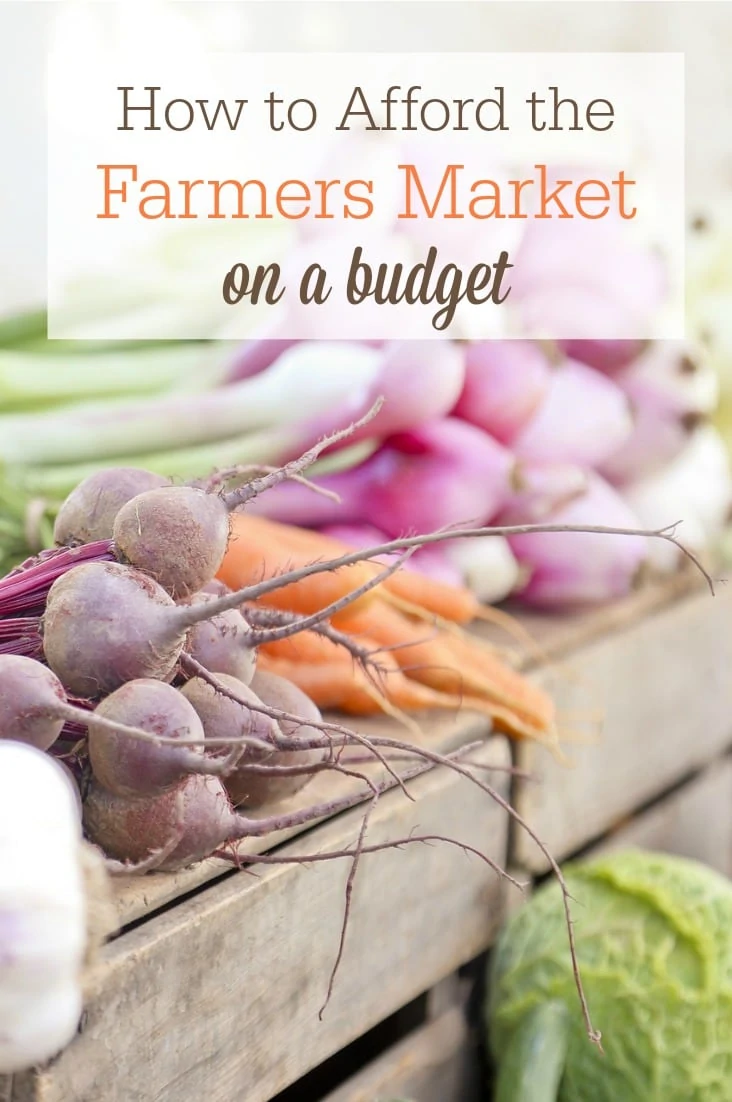
By Tiffany, Contributing Writer
If you’ve never been to a farmer’s market before, you’re in for a treat! You’ll find produce that was picked just days ago – sometimes picked that very same morning! You’ll see vegetables you have never seen before and varieties of fruits you didn’t even know existed.
Unfortunately, you also might experience sticker shock.
For someone who is used to shopping weekly circulars and buying from grocery stores, prices at the farmer’s market can seem high. I used to think this myself, and it’s just one of the many reasons I stopped going to the market last year.
This is not just a course…and it’s not just a bunch of money-saving ideas…it’s a COMPLETE SYSTEM for making real food work for you, your family, and your budget. Find out how it can save you hundreds of dollars a month!
A lot has changed for me since then and I’m finally ready to get back to the farmers markets to enjoy the fresh and delicious produce grown in my area – but not at the sacrifice of my grocery budget!
Here are the 5 strategies I’m using to afford shopping the farmers market on a budget. If you’re looking for more tips to shop and save at the farmers market, check out my Ultimate Guide to Shopping the Farmers Market.
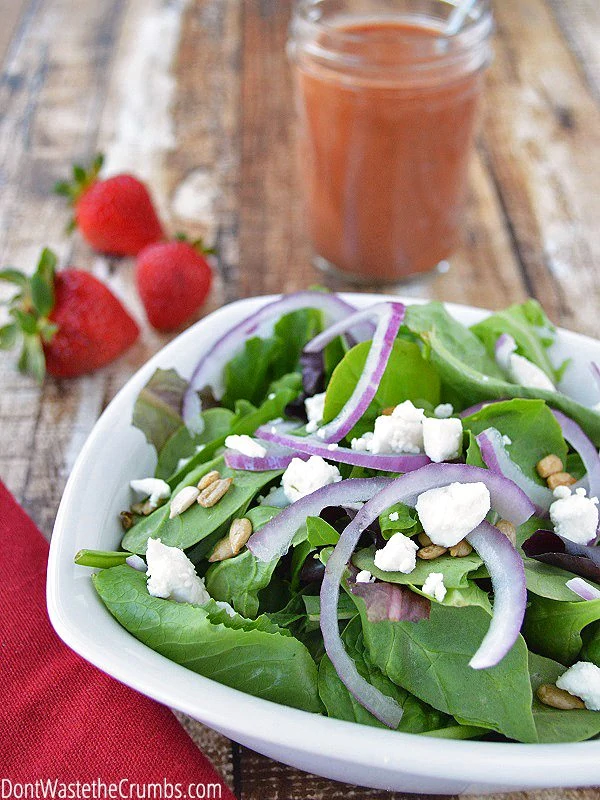
#1. Start with a general meal plan.
Failing to plan is planning to fail, and this phrase holds true to shopping the farmers market without a general idea of what you need and what you’re cooking for dinner. I’m pretty sure I’m not the only one who swooned over pretty produce, bought a pound and stuck it in the fridge when they got home… only to find it wilting and rotting in the produce drawer a week later.
Do yourself a favor and create some sort of plan before you shop. It doesn’t have to be grandiose – in fact, here’s a simple plan you can use any week:
- Monday: Whole Roasted Chicken + Strawberry Spinach Salad + Seared Broccoli
- Tuesday: Cobb Salad using leftover roasted chicken + Homemade Ranch Dressing + Easy Dinner Biscuits
- Wednesday: Pasta with 15 Minute Spaghetti Sauce
- Thursday: Lentil Minestrone Soup + Man Bread
- Friday: Faux Summer Risotto with Caprese Salad
Actually, can I take the task of “meal planning” off your to-do list for you? I created a meal plan membership that includes 3 meals a day for the entire month. It’s a great service for families who hate to meal plan and since it’s seasonal, you can take the shopping lists with you to the farmer’s market! Use the code THH15 to save 15% off either the 3-month paid in full or the one-year paid in full membership.
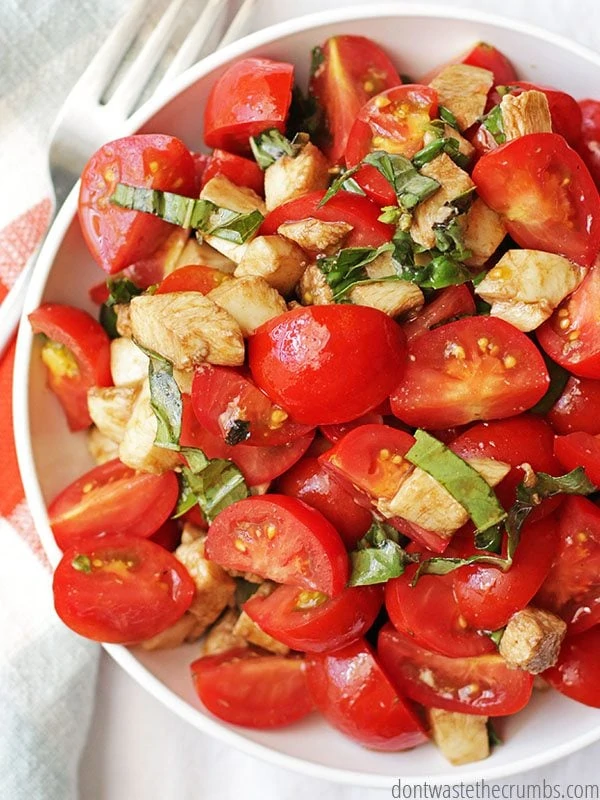
#2. Shop with a flexible shopping list.
With a general meal plan in place, make a general shopping list. You want it to be firm enough so that you get enough greens for salad and vegetables for soup, but one of the perks of shopping at a farmer’s market is the surprise of what’s available from the vendors!
Leave wiggle room on your shopping list in case you find a great deal on zucchini (our favorite zucchini muffins) or a crate full of soft tomatoes (for Cast Iron Pizza of course, then Homemade Canned Diced Tomatoes!).
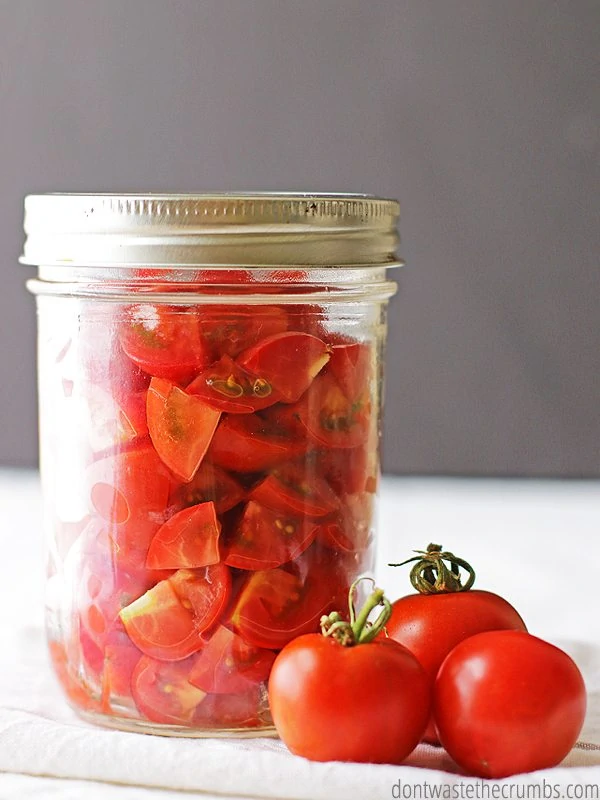
#3. Establish a plan for using what you bring home.
You won’t save any money if what you bring home ends up rotted and in the trash, so make sure you have a plan for everything you bring home – especially if you picked up anything that wasn’t specifically called for on your meal plan.
One reader shared that she puts all the “old” produce in one produce drawer and “new” produce in another. As she cooks her meals, she makes a point to use as much as she can from the “old” drawer before diving into the “new” one.
Personally, I usually default to dehydrating extra fruit (for Homemade Instant Oatmeal Packets), making a main-meal salad at least once during the week and then tossing whatever is leftover at the end of the week into slow cooker soup. If we’re going to a pot-luck, I’ll take all the extras and make Italian Pasta Salad instead.
Tip: Do you struggle with knowing what you have in the house? These inventory sheets are a lifesaver! There’s one for the fridge, freezer and pantry and they’re 100% FREE to download. Print them off, fill them out and tape them to the fridge at the start of each month to help you eat what you have and not buy things you don’t need!

#4. Create a farmers market grocery budget.
Establishing a general grocery budget was key to paying off our massive mound of debt, so I recommend doing that first if you haven’t already. Use this simple process to get started.
Once you have a grocery budget, set aside funds specifically for the farmers market. Why? Because knowing you have money to spend at the market gives you the freedom to splurge on fun finds like kumquats and local blueberries. It also prevents you from blowing the entire monthly budget in one trip!

#5. Walk the whole market before buying anything.
There’s excitement in walking up to the farmers market and taking your time at the booths, but you could be missing out on great produce and great deals if you’re not strategic.
Before you buy anything, make a point to walk the whole market from end to end. Look at the booths, see what they have, look what they’re charging and compare against your shopping list. Bring a pencil with you so you can jot notes along the way.
I’ve found asparagus priced at $1.99/lb on one end, and $2.99/lb at the other. I’ve found one vendor whose berries always taste better (and yet the same price as others) and two years ago I found a vendor who had an enormous selection of vegetables AND he offered a discount when you reached a certain amount! You can bet I made sure to shop him first!

Shopping the farmers market can be a lot of fun and it doesn’t have to cost a lot money, as long as you plan ahead and shop smart! Use these tips, plus the tips in my Ultimate Guide to Shopping the Farmer’s Market to save big and eat healthier this season!
 What do you like to do to afford the farmers market on a budget?
What do you like to do to afford the farmers market on a budget?
Related Posts:
6 Tools to Maximize Local Grocery Savings

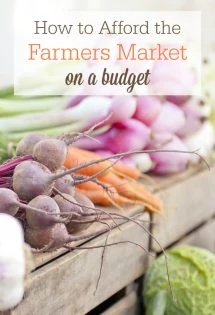
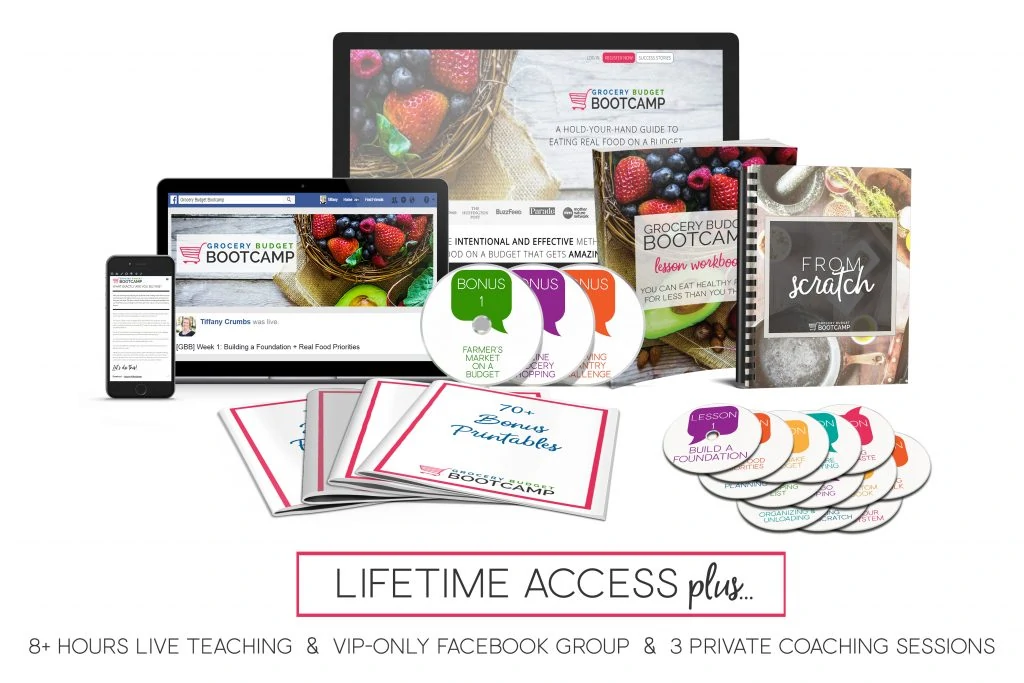

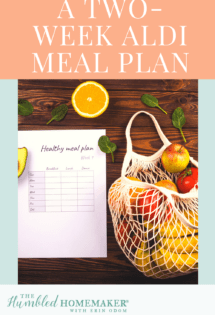


Andria
I want to start getting our produce at the farmer’s market this summer. My plan for meal planning:
-The farmer’s market is open Saturday morning, and I usually grocery shop on Sundays because our local store offers a 10% student discount on that day.
-So, I’ll go on Saturday and get whatever is fresh and looks good (within reason and budget), and then make a meal plan based around that produce (I use plantoeat). I can shop for the other items I need on Sunday.
That way, I’m flexible enough to buy what is in season, but I have a plan for eating everything so it doesn’t go to waste.
Tiffany
That’s a really great plan Andria!!
Kelly Richardson
When you buy from the farmers, growers, ranchers, and producers at local farmers markets, you need to look at more than just the bottom line! Saving money is awesome, but by paying more, your food dollars have more of an impact than you could imagine!
– Food is grown locally: Instead of having your produce trucked in from desinations far away, your produce is grown right around where you live. Many farmers markets have a distance limit as to who can sell there. For example, one of our local markets limits the products being sold to less than 100 m miles away. Consequently, what you buy is riper, fresher, and, in many cases, organically grown.
– You are keeping your money in your community: When you buy from your local farmers, growers, ranchers, and producers, you are keeping money in your community, and not sending it to shareholders somewhere else. When you pay slightly more for fresh local produce, you’re helping someone make their mortgage payment, send their kid to karate lessons, or supplement a household’s income. The money I make with our jam business allows me to take care of our children.
– You are making the case for Farm to Table eating: By knowing your local farmers, growers, ranchers, and producers, supporting them, and purchasing their goods, you are supporting the idea that eating local, eating fresh, and using quality ingredients is important. Farm to Table is about eating what’s in season and using what is fresh and available in your meals all while voting with your dollars.
– Your money can go further: Many farmers markets offer matching dollars for those who are on SNAP. For every SNAP dollar you use, the farmers market will give you matching funds, sometimes offering bonus matching money. That means if you use $25 in SNAP benefits, you’ll have $50 to spend to buy fresh produce, locally made breads and jams, and farm direct proteins like eggs, beef, and chicken.
Since saving money is important, there are many ways to eat locally on a budget and still support local food:
– CSA (Community Supported Agriculture) co-ops often offer shares where you get a box of vegetables each week during their growing season and have the chance to eat within the season.
– Along with CSA’s, many hog or beef producers will offer lower prices if you purchase a whole or half cows or hogs. The price for local beef is expensive when you purchase it piece-meal (ie, steaks one week, ground beef the next), but if you purchase in bulk and freeze it, it’s comprable in price and the quality is so much better.
– Purchase in bulk from farmers/growers: Many growers will make you a deal if you want to purchase large quanities of produce. Instead of purchasing a pound or two of tomatoes, purchase 20 or so, then can, freeze, or process them!
– Make your own local food co-op with your friends: If you get bulk deals from farmers/growers and can’t use the produce, find some friends who can! Get 40 pounds of tomatoes and split them out amongst a few families. Got a deal on a whole cow? Go in halvsies with another family and fill your freezer! Use your combined purchasing power to pass savings along to everyone.
While the bottom line is important to many families, the benefits to eating locally and from your local growers, ranchers, farmers, and producers go beyond what’s in your pocket book.
Sarah@TheOrthodoxMama
I have found that shopping at the smaller farmer’s markets in my area saves me a ton of money. There is a large and (justifiably) famous farmer’s market near us, but its prices are typically double what I pay at our tiny farmer’s market in our own neighborhood. Because there are only a few farmers (4-7 on a typical day), I have gotten to know them personally. They also know me and will give the occasional discount because they know I am a regular customer. So, don’t ignore the tiny markets or food stands–they could save you money and help build relationships!
The Thrifty Issue
This is very useful, particularly for large families. Great tips, thank you! It’s often difficult to keep track on what you have in the fridge and what you need to use quickly before it expires. Farmer’s markets tend to have the best produce but they’re pricey.
Another thing that might be useful is to choose the best time to go to a farmer’s market. Test different days and hours to see which ones give the best results. Sometimes, prices and vendors change so you’ll want to find the best ones.
Jamie@SimpleLivingMommy
These are great tips! I learned the “walk the whole market before buying anything” the hard way when shopping our local farmers market for vegetable plants. The price difference between vendors located just yards from each other is crazy! One vendor selling strawberry plants actually said that other farmers bully her for pricing hers so low because it hurts their price point. Great to know!